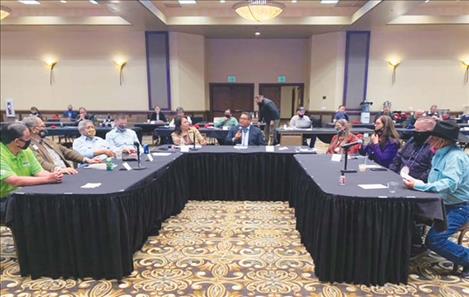Tribes urge Congress to make infrastructure investments
Hey savvy news reader! Thanks for choosing local.
You are now reading
2 of 3 free articles.
News from CSKT
Last Wednesday and Thursday, representatives from 12 different Northwest Tribes spent two days in Mission, OR, discussing a salmon and energy proposal from Rep. Mike Simpson (R-ID) that could make an unprecedented infrastructure investment in the Pacific Northwest. The Columbia Basin Initiative aims to save imperiled salmon runs, protect inland agriculture industries, and transform the region’s energy supply for a renewable future.
The Confederated Salish and Kootenai Tribes, as owners of Séliš, Ksanka and QÍispé Dam on the lower Flathead River, contribute to the Columbia Basin hydropower system and were participants in the session.
Tribal Council Chairwoman Shelly Fyant described Simpson’s proposal as “the most viable path for restoration of Columbia Basin resources. We say this from not only a provider of energy but also as a Bonneville Power preference customer bringing energy from the Columbia Basin Hydropower system to our people.”
“We encourage the rest of the Northwest delegation to join with Representative Simpson to complete this comprehensive plan and commit the resources to implement it,” she said in a prepared statement.
Beyond the bold salmon and river restoration actions throughout the Columbia River Basin, the Simpson proposal could protect salmon, water, agriculture, transportation and energy needs by:
Investing nearly $5 billion in new transportation infrastructure to transport inland products like wheat to market;
Investing over $14 billion in new energy infrastructure, including $2 billion for Northwest grid resiliency/optimization, $1.25 billion for energy storage, and $10 billion in replacement energy for the lower Snake River dams;
Providing Snake/Columbia River communities with over $1.5 billion for economic development;
Placing fish restoration under the direction of tribes and states;
Investing in restoring the lower Snake River by breaching the four lower Snake River dams;
Investing in restoring non-ESA listed fish above blocked areas;
Allocating over $5 billion in other salmon conservation actions throughout the Basin; and
Providing legal certainty on Columbia River dams for 35 years.
The tribes coalesced around the following set of “common ground” principles intended to continue and expand their dialogue with agricultural and energy interests:
The true wealth of our region begins with the health of our rivers, fish and the ecosystem they support, which is our culture, history, and future;
Agriculture is an important part of our region’s economy;
Affordable and reliable power is important to regional families and business – tribal and non-tribal;
Providing legal certainty for the vast majority of federal dams in the Columbia/Snake River basins is a necessary element of a lasting solution;
A significant federal infrastructure investment in alternative energy and transportation provides a unique opportunity to restore salmon while keeping power affordable and maintaining agricultural commerce;
A comprehensive legislative solution is preferable to all other avenues and is urgently needed.
The time for action is now. The Columbia Basin cannot become another Klamath Basin crisis.
On his website, Simpson acknowledges that he’s proposing a solution to a very contentious issue. “A concept like this will take all the Northwest delegation, governors, tribes, and stakeholders working together to draft a solution. It will be no easy task and on a very tight timeline,” he writes.
On the other hand, Simpson notes, “It would be a tragedy if future generations looked back and wished that we had at least taken the time to explore this opportunity to develop our own Northwest solution to protect stakeholders and save salmon.”
For more information on the Columbia Basin Initiative, visit simpson.house.gov/salmon.
















